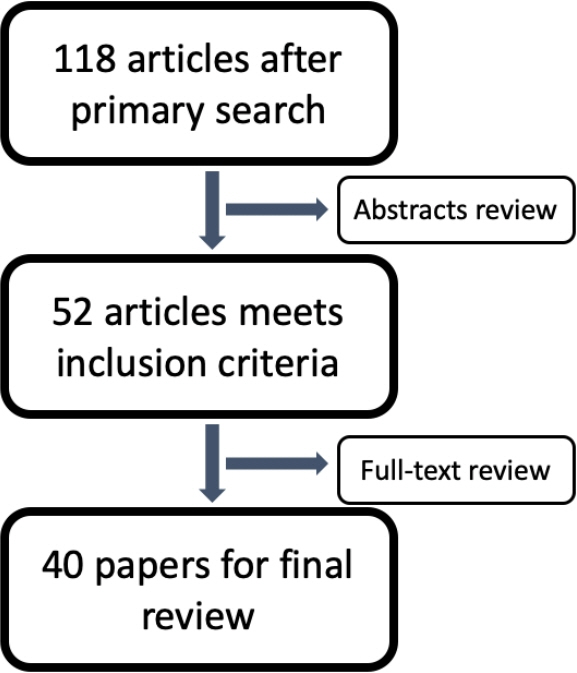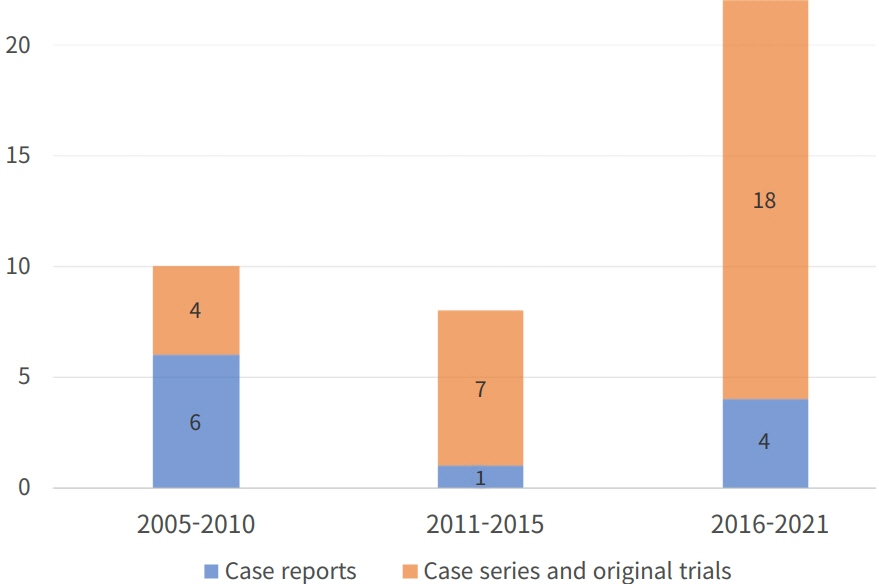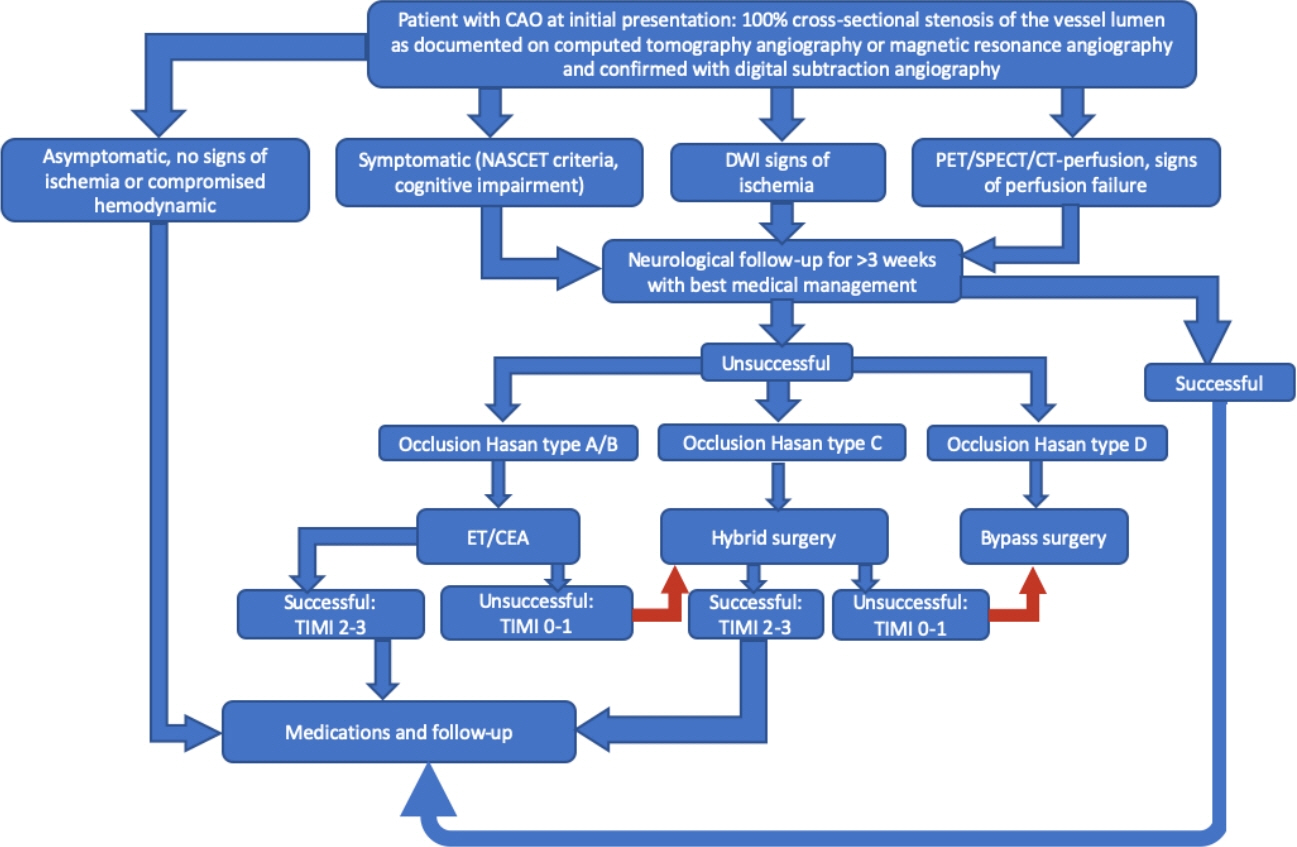J Cerebrovasc Endovasc Neurosurg.
2023 Mar;25(1):1-12. 10.7461/jcen.2022.E2022.03.008.
Sixteen years progress in recanalization of chronic carotid artery occlusion: A comprehensive review
- Affiliations
-
- 1Department of Neurosurgery, Main Military Hospital Named after N.N. Burdenko, Moscow, Russia
- 2Department of Neurosurgery, Military Medical Academy Named after S.M. Kirov, Saint-Petersburg, Russia
- KMID: 2540802
- DOI: http://doi.org/10.7461/jcen.2022.E2022.03.008
Abstract
Objective
Although chronic carotid artery occlusion seems to be associated with significant risk of ischemic stroke, revascularization techniques are neither well established nor widespread. In contrast, extracranial-intracranial bypass is common despite the lack of evidence regarding neurological improvement or prevention of ischemic events. The aim of current review is to evaluate the effectiveness of various methods of recanalization of chronic carotid artery occlusion.
Methods
Comprehensive literature search through PubMed, Scopus, Cochrane and Web of Science databases performed. Various parameters were assessed among patients underwent surgical, endovascular and hybrid recanalization for chronic carotid artery occlusion.
Results
40 publications from 2005 to 2021 with total of more than 1300 cases of revascularization of chronic carotid artery occlusion have been reviewed. Further parameters were assessed among patients underwent surgical, endovascular and hybrid recanalization for chronic carotid artery occlusion: mean age, male to female ratio, mean duration of occlusion before treatment, rate of successful recanalization, frequency of restenosis and reocclusion, prevalence of ischemic stroke postoperatively, neurological or other symptoms improvement and complications. Based on proposed through reviewed literature indications for revascularization and predictive factors of various recanalizing procedures, an algorithm for clinical decision making have been formulated.
Conclusions
Although treatment of chronic carotid artery occlusion remains challenging, current literature suggests revascularization as single option for verified neurological improvement and prevention of ischemic events. Surgical and endovascular procedures should be taken into account when treating patients with symptomatic chronic carotid artery occlusion.
Keyword
Figure
Reference
-
1. Adams HP Jr, Power WJ, Grubb RL Jr, Clarke WR, Woolson RF. Preview of a new trial of extracranial-to-intracranial arterial anastomosis: the carotid occlusion surgery study. Neurosurg Clin N Am. 2001; Jul. 12(3):613–24. ix–x.2. Babić S, Tanasković S, Nešković M, Gajin P, Nenezić D, Stevanović P, et al. Surgical treatment of proximal segmental occlusion of the internal carotid artery. Surg Res Pract. 2019; Jan. 2019:2976091.3. Barnett HJ. Status report on the North American symptomatic carotid surgery trial. J Mal Vasc. 1993; 18(3):202–8.4. Buslovich S, Hines GL. Spontaneous recanalization of chronic internal carotid artery occlusions: report of 3 cases. Vasc Endovascular Surg. 2011; Jan. 45(1):93–7.5. Cagnazzo F, Lefevre PH, Derraz I, Dargazanli C, Gascou G, Riquelme C, et al. Endovascular recanalization of chronically occluded internal carotid artery. J Neurointerv Surg. 2020; Oct. 12(10):946–51.6. Chen YH, Leong WS, Lin MS, Huang CC, Hung CS, Li HY, et al. Predictors for successful endovascular intervention in chronic carotid artery total occlusion. JACC Cardiovasc Interv. 2016; Sep. 9(17):1825–32.7. De Bakey ME, Crawford ES, Cooley DA, Morris GC Jr, Edward Garret H, Fields WS. Cerebral arterial insufficiency: one to 11-year results following arterial reconstructive operation. Ann Surg. 1965; Jun. 161(6):921–45.8. Fan YL, Wan JQ, Zhou ZW, Chen L, Wang Y, Yao Q, et al. Neurocognitive improvement after carotid artery stenting in patients with chronic internal carotid artery occlusion: a prospective, controlled, single-center study. Vasc Endovascular Surg. 2014; May. 48(4):305–10.9. Flaherty ML, Flemming KD, McClelland R, Jorgensen NW, Brown RD Jr. Population-based study of symptomatic internal carotid artery occlusion: Incidence and long-term follow-up. Stroke. 2004; Aug. 35(8):e349–52.10. Fluri F, Engelter S, Lyrer P. Extracranial‐intracranial arterial bypass surgery for occlusive carotid artery disease. Cochrane Database Syst Rev. 2010; Feb. 17. 2010(2):CD005953.11. Galkin PV, Gushcha AO, Antonov GI. Surgical treatment of the internal carotid artery atherosclerotic occlusion. Zh Nevrol Psikhiatr Im S S Korsakova. 2014; 114(7):67–72.12. Gomensoro JB. Joint study of extracranial arterial occlusion: VIII. Clinical-radiographic correlation of carotid bifurcation lesions in 177 patients with transient cerebral ischaemic attacks. JAMA. 1973; May. 224(7):985–91.13. Grubb RL Jr, Derdeyn CP, Fritsch SM, Carpenter DA, Yundt KD, Videen TO, et al. Importance of hemodynamic factors in the prognosis of symptomatic carotid occlusion. JAMA. 1998; 280(12):1055–60.14. Grubb RL Jr, Powers WJ, Clarke WR, Videen TO, Adams HP Jr, Derdeyn CP, et al. Surgical results of the carotid occlusion surgery study. J Neurosurg. 2013; Jan. 118(1):25–33.15. Hackam DG. Prognosis of asymptomatic carotid artery occlusion: systematic review and meta-analysis. Stroke. 2016; May. 47(5):1253–7.16. Hasan D, Zanaty M, Starke RM, Atallah E, Chalouhi N, Jabbour P, et al. Feasibility, safety, and changes in systolic blood pressure associated with endovascular revascularization of symptomatic and chronically occluded cervical internal carotid artery using a newly suggested radiographic classification of chronically occluded cervical internal carotid artery: pilot study. J Neurosurg. 2018; May. 1–10.17. Hauck EF, Ogilvy CS, Siddiqui AH, Hopkins LN, Levy EI. Direct endovascular recanalization of chronic carotid occlusion: should we do it? Case report. Neurosurgery. 2010; Oct. 67(4):E1152–9. discussion E1159.18. Hu Y, Qian H, Shi X. Treatment of chronic internal carotid artery occlusion by ipsilateral external carotid endarterectomy. Br J Neurosurg. 2020; Feb. 1–3.19. Hudson JS, Zanaty M, Wadman V, Nakagawa D, Ishii D, Roa JA, et al. Bradycardia and asystole in patients undergoing symptomatic chronically occluded internal carotid artery recanalization. World Neurosurg. 2019; Nov. 131:e211–7.20. Ishikawa T, Kuroda S, Hokin K, Kamiyama H, Abe H. Can EC-IC bypass prevent brain ischemia from recurring? No Shinkei Geka. 1998; Sep. 26(9):823–9.21. JET Study Group. Japanese EC-IC bypass trial (JET study): study design and interim analysis. Surg Cereb Stroke. 2002; 30(2):97–100.22. Jiang WJ, Liu AF, Yu W, Qiu HC, Zhang YQ, Liu F, et al. Outcomes of multimodality in situ recanalization in hybrid operating room (MIRHOR) for symptomatic chronic internal carotid artery occlusions. J Neurointerv Surg. 2019; Aug. 11(8):825–32.23. Kao HL, Lin MS, Wang CS, Lin YH, Lin LC, Chao CL, et al. Feasibility of endovascular recanalization for symptomatic cervical internal carotid artery occlusion. J Am Coll Cardiol. 2007; Feb. 49(7):765–71.24. Klijn CJ, van Buren PA, Kappelle LJ, Tulleken CA, Eikelboom BC, Algra A, et al. Outcome in patients with symptomatic occlusion of the internal carotid artery. Eur J Vasc Endovasc Surg. 2000; Jun. 19(6):579–86.25. Lee CW, Lin YH, Liu HM, Wang YF, Chen YF, Wang JL. Predicting procedure successful rate and 1-year patency after endovascular recanalization for chronic carotid artery occlusion by CT angiography. Int J Cardiol. 2016; Oct. 221:772–6.26. Li J, Wang C, Zou S, Liu Y, Qu L. Hybrid surgery for nontaper or nonstump lesions in symptomatic subacute or chronic internal carotid occlusion: a better solution. World Neurosurg. 2019; Feb. 122:e1416–25.27. Lin MS, Chiu MJ, Wu YW, Huang CC, Chao CC, Chen YH, et al. Neurocognitive improvement after carotid artery stenting in patients with chronic internal carotid artery occlusion and cerebral ischemia. Stroke. 2011; Oct. 42(10):2850–4.28. Lin MS, Lin LC, Li HY, Lin CH, Chao CC, Hsu CN, et al. Procedural safety and potential vascular complication of endovascular recanalization for chronic cervical internal carotid artery occlusion. Circ Cardiovasc Interv. 2008; Oct. 1(2):119–25.29. Liu B, Wei W, Wang Y, Yang X, Yue S, Zhang J. Estimation and recanalization of chronic occluded internal carotid artery: hybrid operation by carotid endarterectomy and endovascular angioplasty. World Neurosurg. 2018; Dec. 120:e457–65.30. Liu Y, Jia L, Liu B, Meng X, Yang J, Li J, et al. Evaluation of endarterectomy recanalization under ultrasound guidance in symptomatic patients with carotid artery occlusion. PLoS One. 2015; Dec. 10(12):e0144381.31. Morris-Stiff G, Teli M, Khan PY, Ogunbiyi SO, Champ CS, Hibberd R, et al. Internal carotid artery occlusion: its natural history including recanalization and subsequent neurological events. Vasc Endovascular Surg. 2013; Nov. 47(8):603–7.32. Nico L, Cester G, Viaro F, Baracchini C, Causin F. Endovascular recanalization of the common carotid artery in a patient with radio induced chronic occlusion. BMJ Case Rep. 2016; Nov. 2016:bcr2016012722.33. Ogasawara K, Yukawa H, Kobayashi M, Mikami C, Konno H, Terasaki K, et al. Prediction and monitoring of cerebral hyperperfusion after carotid endarterectomy by using singlephoton emission computerized tomography scanning. J Neurosurg. 2003; Sep. 99(3):504–10.34. Ohki T, Parodi J, Veith FJ, Bates M, Bade M, Chang D, et al. Efficacy of a proximal occlusion catheter with reversal of flow in the prevention of embolic events during carotid artery stenting: an experimental analysis. J Vasc Surg. 2001; Mar. 33(3):504–9.35. Paty PSK, Adeniyi JA, Mehta M, Darling RC III, Chang BB, Kreienburg PB, et al. Surgical treatment of internal carotid artery occlusion. J Vasc Surg. 2003; Apr. 37(4):785–8.36. Rostambeigi N, Khatri R, Hassan AE, Qureshi AI. Duplex ultrasound assisted endovascular revascularization of chronic internal carotid artery occlusion: technical note. J Vasc Interv Neurol. 2013; Dec. 6(2):42–6.37. Rutgers DR, Klijn CJ, Kappelle LJ, van Huffelen AC, van der Grond J. A longitudinal study of collateral flow patterns in the circle of Willis and the ophthalmic artery in patients with a symptomatic internal carotid artery occlusion. Stroke. 2000; Aug. 31(8):1913–20.38. Sasoh M, Ogasawara K, Kuroda K, Okuguchi T, Terasaki K, Yamadate K, et al. Effects of EC-IC bypass surgery on cognitive impairment in patients with hemodynamic cerebral ischemia. Surg Neurol. 2003; Jun. 59(6):455–60. discussion 460.39. Schaafsma A, Veen L, Vos JP. Three cases of hyperperfusion syndrome identified by daily transcranial Doppler investigation after carotid surgery. Eur J Vasc Endovasc Surg. 2002; Jan. 23(1):17–22.40. Schmiedek P, Piepgras A, Leinsinger G, Kirsch CM, Einhupl K. Improvement of cerebrovascular reserve capacity by ECIC arterial bypass surgery in patients with ICA occlusion and hemodynamic cerebral ischemia. J Neurosurg. 1994; Aug. 81(2):236–44.41. Shih YT, Chen WH, Lee WL, Lee HT, Shen CC, Tsuei YS. Hybrid surgery for symptomatic chronic total occlusion of carotid artery: a technical note. Neurosurgery. 2013; Sep. 73(1 Suppl Operative):onsE117–23. discussion onsE123.42. Shojima M, Nemoto S, Morita A, Miyata T, Namba K, Tanaka Y, et al. Protected endovascular revascularization of subacute and chronic total occlusion of the internal carotid artery. AJNR Am J Neuroradiol. 2010; Mar. 31(3):481–6.43. Shucart WA, Garrido E. Reopening some occluded carotid arteries. Report of four cases. J Neurosurg. 1976; Oct. 45(4):442–6.44. Sundaram S, Kannoth S, Thomas B, Sarma PS, Sylaja PN. Collateral assessment by CT angiography as a predictor of outcome in symptomatic cervical internal carotid artery occlusion. AJNR Am J Neuroradiol. 2017; Jan. 38(1):52–7.45. Terada T, Yamaga H, Tsumoto T, Masuo O, Itakura T. 2005. Use of an embolic protection system during endovascular recanalization of a totally occluded cervical internal carotid artery at the chronic stage. J Neurosurg. 2005; Mar. 102(3):558–64.46. The EC-IC Bypass Study Group. Failure of extracranial-intracranial arterial bypass to reduce the risk of ischemic stroke. Results of an international randomized trial. N Engl J Med. 1985; Nov. 7. 313(19):1191–200.47. Thompson JE, Austin DJ, Patman RD. Carotid endarterectomy for cerebrovascular insufficiency: long-term results in 592 patients followed up to thirteen years. Ann Surg. 1970; Oct. 172(4):663–79.48. Uno T, Shojima M, Oyama Y, Yamane F, Matsuno A. Retrograde endovascular revascularization for chronic total occlusion of the internal carotid artery: a case report. Acta Neurochir (Wien). 2022; Apr. 164(4):1015–9.49. Xu B, Li C, Guo Y, Xu K, Yang Y, Yu J. Current understanding of chronic total occlusion of the internal carotid artery. Biomed Rep. 2018; Feb. 8(2):117–25.50. Yang Y, Liu X, Wang R, Zhang Y, Zhang D, Zhao J. A treatment option for symptomatic chronic complete internal carotid artery occlusion: hybrid surgery. Front Neurosci. 2020; Apr. 14:392.51. Zanaty M, Howard S, Roa JA, Alvarez CM, Kung DK, McCarthy DJ, et al. Cognitive and cerebral hemodynamic effects of endovascular recanalization of chronically occluded cervical internal carotid artery: single-center study and review of the literature. J Neurosurg. 2019; Mar. 132(4):1158–66.
- Full Text Links
- Actions
-
Cited
- CITED
-
- Close
- Share
- Similar articles
-
- Spontaneous Recanalization from Traumatic Internal Carotid Artery Occlusion
- Urgent Recanalization Using Stents for Acute Internal Carotid Artery Occlusion in Progressive Stroke Patients with Contralateral Chronic Carotid Occlusion
- Carotid Artery Stenting in a Patient with Spontaneous Recanalization of a Proximal Internal Carotid Artery Occlusion: a Case Report
- Aspiration Clot Removal by Mannual Compression of Common Carotid Artery for Acute Internal Carotid Occlusion: a Case Report
- Multiple Carotid Artery Occlusive Diseases Treated with Staged Subclavian-carotid Artery bypass and Carotid Endarterectomy: Case Report




